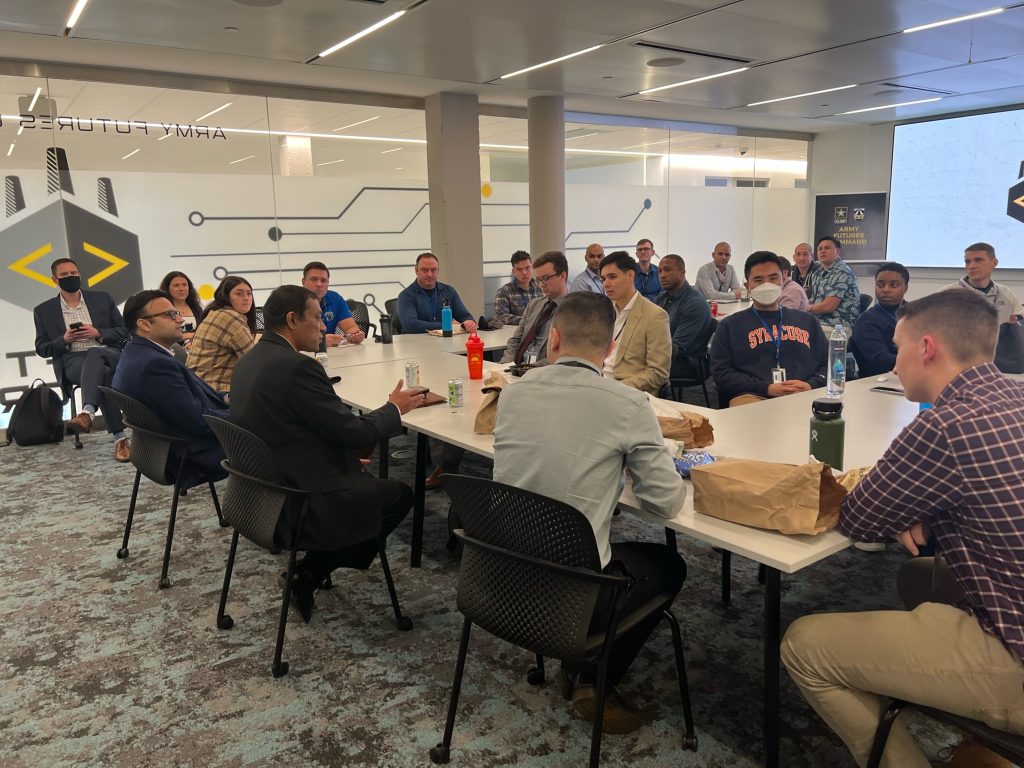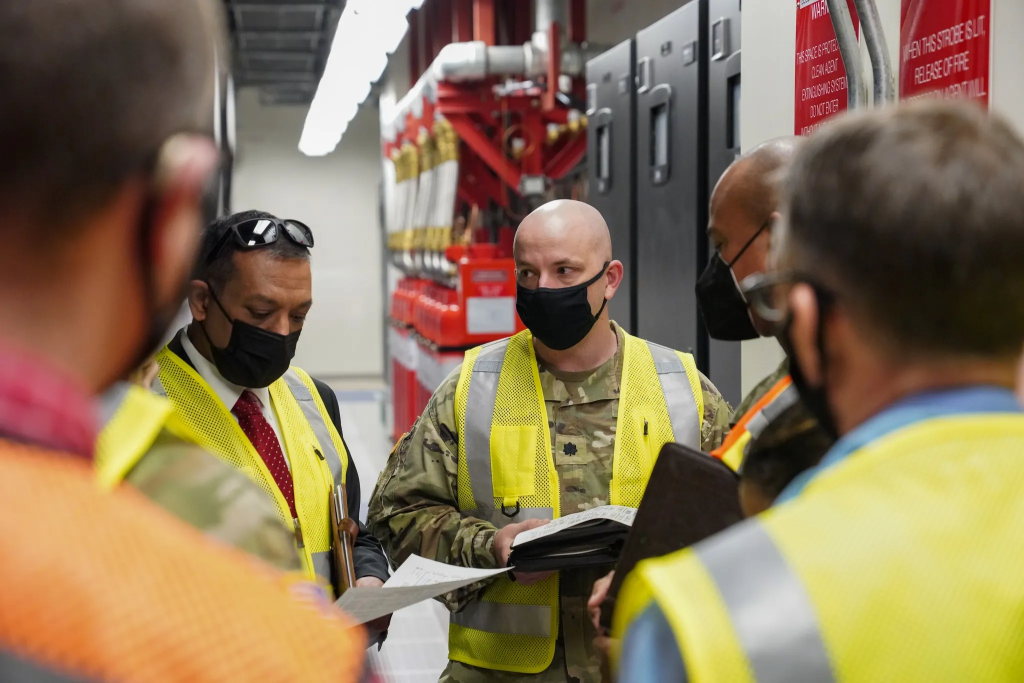
DIGITAL TRANSFORMATION: As the keynote speaker at the 6th Annual Business Analytics Symposium held at the University of Texas at Arlington in March, Iyer highlighted relevant details about digital transformation within the Army. (Photo provided by University of Texas at Arlington Public Affairs Office)
From the Army Chief Information Officer
Dr. Raj Iyer
The speed of technology change and agility needed to support a software-intensive Army is one that requires a massive reform of our institutional processes.
Over the last decade, commercial industry has made radical shifts in how it manages the software life cycle from requirements through support fueled by digital transformation and new technologies, such as cloud computing and development paradigms like DevSecOps. In the consumer world, we saw the proliferation of mobile applications for all kinds of new disruptive services like ride sharing (Uber, Lyft), food delivery (DoorDash, Uber Eats), car sharing (Turo), home rentals (Airbnb) and even over-the-air software updates to cars (Tesla). Each of these disruptions in the consumer world created innovative delivery models for services using data as a strategic asset to give these companies tremendous competitive advantage over their non-digital peers. These disruptors also changed the nature of their industry as a whole, and in many cases reinvented their own companies.
The U.S. Army is on a similar path to achieve the objectives for the Army of 2030. We can draw clear analogies between digital transformation in the consumer world to the Army, which has also recognized that data is the new ammunition as we fight in new ways through our modernization efforts. Multidomain operations is how we will establish strategic deterrence against near-peer adversaries in great power competition and, if needed, fight and win decisively in a large scale combat operation. This is how the Army is transforming its “business” model—warfighting—while at the same time transforming our force structure and institutional processes to better align with how we will deliver multidomain effects in a fight.

SIGNIFICANCE OF SOFTWARE: Iyer speaks to Army Software Factory cohort students at an Army Futures Command luncheon on March 22, to impress upon them the significance of software modernization and their role in leading the change. (Photo provided by Army Futures Command, Public Affairs Office)
Each of the Army’s modernization programs—long range precision fires, next generation combat vehicle, future vertical lift, Soldier lethality, synthetic training environment and the unified network have one thing in common. They are all software intensive systems, and unlike traditional weapon systems platforms, it is the software enabled by artificial intelligence that powers the platform’s lethality and survivability. As such, the Army is moving into a high tech, software-intensive world, one that is not compatible with all of our institutional processes like requirements development, acquisition management, planning programming budgeting and execution (PPBE), test and evaluation, cybersecurity, talent management, and others. The speed of technology change and agility needed to support a software-intensive Army is one that requires a massive reform of our institutional processes that had mostly operated on timelines that is measured in years, and not days, and there are some challenges that we need to overcome.
REQUIREMENTS DEVELOPMENT FOR SOFTWARE
Modern commercial software has recognized that software is never done. It begins with a minimum viable product and is then incrementally deployed with new features and functions based on user feedback. While a high-level product roadmap is established, detailed requirements are not written for software. How the software is used and how well it works in the real world drives the prioritization for updates to the software.
However, in the Army we rely heavily on documented functional requirements documents that take years to write before they can be turned over to build. Such an approach assumes that we know all of the requirements upfront, when we do not, and impedes innovation in applying the right technology solution to meet the requirement. When the software being implemented is used to modernize an existing legacy system, the system requirements are heavily biased by how the legacy system operates vice reimagining a new way to achieve the same outcomes. The Army must adopt human-centered design approaches to ensure user feedback early and often and iterate to achieve the end-state while keeping requirements at a high level and focused on mission outcomes.

CLOUD CONCEPTS: Iyer and a panel of peers discuss the importance of cloud technology as a catalyst for change and modernization. (Photo provided by Army Futures Command, Public Affairs Office)
SOFTWARE ACQUISITION
When requirements eventually flow into acquisition to develop and deploy new software, the Army has traditionally taken a “big bang” multi-year approach to build and deploy capability. Even in select programs that have adopted development methodologies, the software product does not get into the hands of the users early in the life cycle for feedback. Instead, these software builds are consolidated into larger increments, which then go through further integration-testing and eventually user-acceptance testing before they’re deployed.
Such an approach is not truly Agile. Compounding the problem is the enormous documentation that is required by our acquisition processes that includes various plans, reports and contract deliverables. Agile development is all about delivering a usable product, and if the Agile methodology is implemented correctly, that can be delivered with minimal documentation. For formal acquisition programs, the Army has not fully leveraged the flexibility and agility that comes with new acquisition models such as the software acquisition pathways that is based on modern commercial software development best practices. The Army must take advantage of these authorities, organize ourselves as Agile product teams, and focus on delivering high quality user experience through micro applications delivered in weeks and not years.

TRANSFORMATIONAL INITIATIVES: At United States Army, Japan (USARJ) Iyer talks command, control, computers, communications, cyber, intelligence, surveillance and reconnaissance initiatives, as well as insight about U.S.-Japan interoperability. (Photo provided by USARJ Public Affairs Office)
BUDGETING FOR SOFTWARE
The Army’s current software life cycle processes are waterfall-based and defined by milestones and gates. As such, it is assumed that all software development will happen in linear steps moving from design to development to test to fielding and finally to sustainment. The way we budget for the software life cycle follows this waterfall approach whereby we budget using research, development, test and evaluation funds for development and testing, other procurement, Army to procure hardware and software, and, finally, using operations and maintenance, Army funds for sustainment. DOD fiscal laws drive this distinction across various colors of funding, and strict rules for what type of activity can be conducted in each phase of the life cycle. Any transfer of funds across these colors of funding can require lengthy and complex reprogramming efforts and even Congressional approval. This model falls apart quickly when we leverage Agile development.
Once the minimum viable product is deployed, not only is it continually sustained but new capability and enhancements are implemented at the same time, making distinctions between colors of funding almost impossible to ascertain. This leads to subjective legal opinions for how to allocate funding in later phases of the software life cycle, all of which leads to potentially artificial decisions being made to apply the right color of funds to the project to ensure compliance.
The DOD and Congress recognized the need for “colorless” funds for software and have established a pilot called the Budget Activity 8 (BA8) to address this challenge. The Army currently has only software programs under this effort, and we must expand and scale the number of programs under this pilot to maximize the benefits available through the pilot, while at the same time working with Congress to find an enduring solution to the problem.

BENEFICIAL VISIT: Iyer paid a visit to a data center still under construction in South Korea, in March 2022, to assess progress and problem areas in development of the center. (Photo provided by 8th Army Public Affairs Office)
TEST AND EVALUATION FOR SOFTWARE
Software that is embedded in weapon systems are required to go through extensive test and evaluation activities—developmental testing, independent operational testing, interoperability testing, Section 508 testing; and various certifications such as Army interoperability certification, before the software can be deployed into the weapon system platform. However, these activities follow a very waterfall approach and require a great deal of documentation to complete. Many of the test cases are duplicative and repetitive, or non-value added. To deliver software in small increments we will need to reform the Army’s test and evaluation processes to become more agile.
The only true measure of whether a software works as intended is to get it in the hands of real users early and often for real feedback. Using accredited development platforms and tools and a standard architecture can ensure interoperability upfront, and keep the focus on delivering usable software to users. For tactical systems and deployments, leveraging modeling and simulation tools, virtual testbeds or even digital twins is how the Army can reduce the need for test and evaluation on physical platforms. The Army’s Joint Systems Integration Laboratory (JSIL) is an example of how we must address testing and certifications in the future.

HIGHLIGHTING ARCHITECTURE AND INFRASTRUCTURE: During a visit to South Korea, in March 2022, Iyer participated in discussions with senior leaders on current command initiatives and the unique joint mission that exists in Korea. Highlights included briefs on Zero Trust Architecture and Virtual Desktop Infrastructure. (Photo provided by 8th Army Public Affairs Office)
CYBERSECURITY
These concepts are core to the DevSecOps framework that is widely adopted by industry to build, deploy and operate software through extensive automation. DevSecOps also supports the concept of a continuous ATO (cATO) where as long as the software is built in an accredited DevSecOps platform with the right processes and controls, any software application developed can be instantaneously deployed obviating the need for many months of separate cybersecurity processes to achieve an ATO. The Army’s CReATE DevSecOps platform in the cARMY cloud is one such example, and has validated tremendous reductions in cycle times through its usage by the Army Software Factory. The Army must move towards DevSecOps for all software applications in the future, in order to increase agility and velocity.
CONCLUSION
The Army has a tremendous opportunity to reform these institutional processes now, but these are not just Army pain points, they are DOD-wide. We need to leverage existing authorities where available such as the software acquisition pathway, optimize our internal processes to be more agile and flexible where possible, and then work across the DOD and joint community to seek solutions for others. Without this much needed reform, the Army risks continuing to fall behind, risking our ability to modernize for the Army of 2030.
For more information, go to https://www.army.mil/cio.
RAJ IYER is the U.S. Army chief information officer for information technology reform. Prior to his current role, Iyer served as the managing director for government and public services and senior manager, technology strategy, defense and national security for Deloitte Consulting. He has held various roles in information technology within the commercial and military space. His top civilian awards and professional achievements include the Meritorious Civilian Service Award, the International William Conroy Standards Professional Award, and dozens of published peer-reviewed papers. He holds a Ph.D. in electrical engineering from the University of Texas, an MBA from the Ross School of Business, University of Michigan, an M.S. in electrical engineering from the University of Texas, and a B.S. in electrical engineering from India’s National Institute of Technology.







